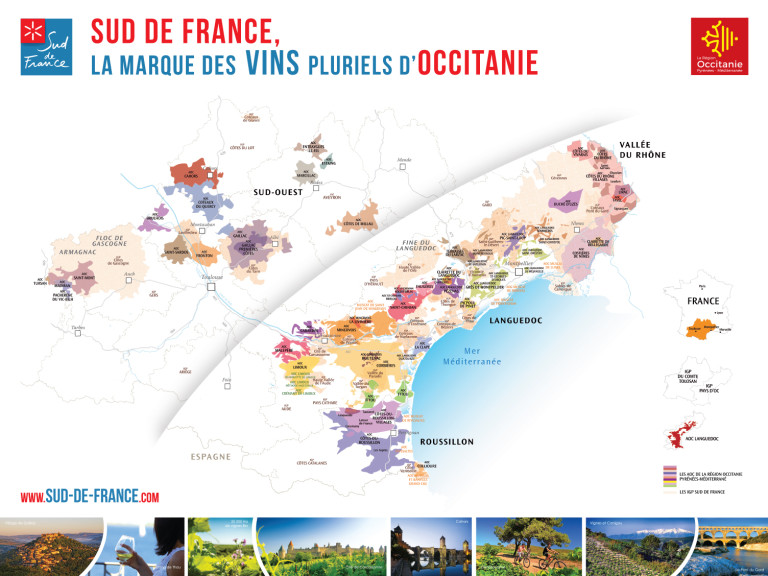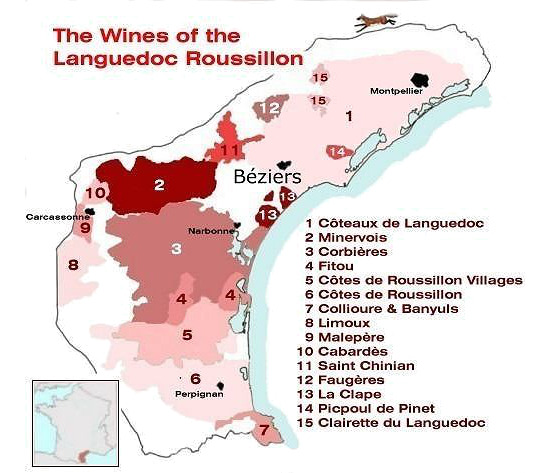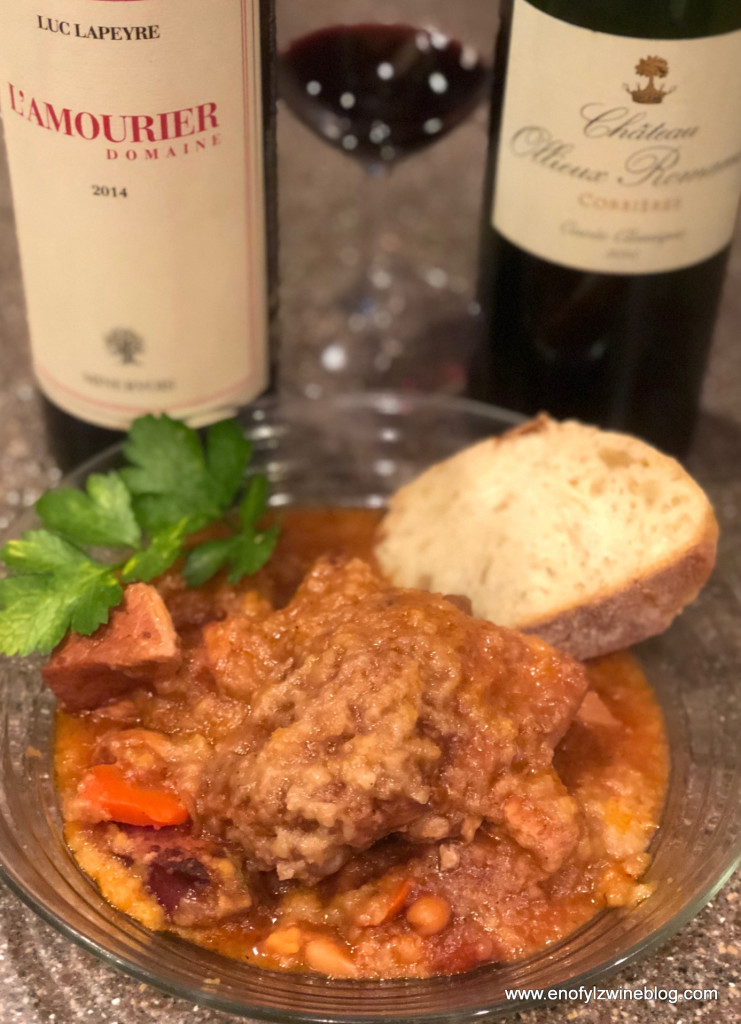This month the French Winophiles are exploring Occitanie – formerly Languedoc-Rousillion; and in particular the AOPs of Minervois and Corbières. And what better way to explore a wine region that simultaneously exploring its gastronomy.
Certain wines are always paired with certain dishes because they come from the same “paese” or region, and therefore have traditionally been served together. Joyce Goldstein
And speaking of food and wine, I’m a believer in the food and wine pairing axiom “what grow together, goes together”. Whenever, I think of the phrase, I think of pairing the food and wines because they have traditionally been served together. Though the phrase might also refer foods that grow together seasonally being compatible at the table, or the way foods and wines express the soil, climate and topography of a region.
In the case of the famous French dish, cassoulet, which originated in the Occitanie (formerly Languedoc) region, all of the above are likely true to one extent or another.
And that is why many of my fellow #Winophiles and I are making this quintessential French casserole!
On My Plate
Perhaps there is no dish in the Southwest France more iconic, cherished, and controversial than the cassoulet. Cassoulet was originally food of peasants–a simple assemblage of what ingredients were available: white beans with pork, sausage, duck confit, gizzards, cooked together for a long time. Since its composition is based on availability, cassoulet varies from town to town in Southwest France according to D’Artagnan who recently sponsored Cassoulet Day.
I used the crock pot version of the Genius Kitchen Cheats French Cassoulet (click here for recipe) because it had all the elements of a traditional French Cassoulet – assorted meats, beans, carrots, tomatoes and wine. I modified the recipe a bit by adding chicken thighs and caramelized tomato paste to add some depth to the sauce.
The recipe turned out very well. And like, seemingly all ethnic stews, the cassoulet was even better a day or two later!
In My Glass
I received two sample wines (I received no other compensation. Thoughts, opinions are my own) for this event; one each from the featured regions for this month’s event – Corbieres and Minervois, which are sub-regions of Occitanie.
Never heard of Occitanie? Neither had I until late last year, when I wrote about a great wine from the Minervois La Liviniere.
About Occitanie
Occitanie (Occitania) is the official name of one of the new regions of France which was formed by combining the neighboring regions of Languedoc-Roussillon and Midi-Pyrénées, during the restructuring of France’s regions in January 2016. (The term, which dates to the Middle Ages, refers to a large southern European realm where people spoke a Latin derived language called Occitan).

Both Languedoc-Roussillon and Midi-Pyrénées regions are very complementary and their combined strength means that Occitanie is now the largest region in France for wine, agriculture and organic agriculture – Isabelle Kanaan, executive director of Sud de France
I think you’ll continue to see Languedoc or Languedoc-Roussillon for some time because it will take time for Occitanie to take hold.
Check out the Sud de France website to learn more about the region’s export ambitions, wine culture, products and tourist
Image courtesy of

The first of the two wine tasted (and the one I used for my recipe) was from the Corbieres.
The Corbieres appellation covers a large, roughly square area, 37 miles (57km) wide, to the south and west of Narbonne. The terrain and climate here vary considerably, ranging from the Pyrenean foothills in the south and west, to the flatter, lower-lying areas of the coastal plain near Narbonne. Because of this the zone has been divided into various sub-appellations – terroirs – which may add their names to that of the Corbieres appellation on labels according to Wine-Searcher.com. The region, which was granted AOP status in 2005, is most renown for its rich, herb-scented wines, made from Grenache, Syrah, Mourvedre and Carignan.
My tasting notes on the wine follow:
2015 Château Ollieux Romanis Corbières Cuvée Classique – France, Languedoc Roussillon, Languedoc, Corbières
Color – Opaque violet
Aromas – Red fruit, licorice, garrigue and spice
Body – Medium-bodied and fruity with mouth-watering acidity and a supple mouth feel with well-integrated velvety tannins
Taste – Black cherry, black raspberry, spice with some nice savory notes
Finish – Medium
A wonderful value at $14 for this delightful weeknight wine. It’s a blend of 40% Carignan, 30%Grenache, 30% Syrah. 14.5% abv (89 pts.)
2014 Luc Lapeyre Minervois L’Amourier – France, Languedoc-Roussillon, Languedoc, Minervois
Color – Opaque purple
Aromas – Black and red fruit, lavender, spice, and black licorice with hints of dusty earth and espresso
Body – Medium-bodied, dry and fresh with well-integrated dusty tannins and a supple mouth-feel
Taste – Juicy blackberry, black cherry, raspberry and warm spice
Finish – Medium+
Another wonderful weeknight wine that offers wonderful value at $15. It’s a blend of 40% Syrah, 20% Grenache, 20% Carignan, 20% Mourvèdre. 13.5% abv. L’Amourier means “blackberry” in the ancient Occitan language of southern France. (90 pts.)
Both wines paired wonderfully with my cassoulet!
Check out other wines and cassoulet my fellow #winophiles are bringing to our virtual table this month!
- Wendy from A Day in the Life on the Farm: A Classic Pairing; Revisiting Languedoc
- Lauren from The Swirling Dervish: Warming Up with the Wines of Corbieres and Minervois
- Camilla from Culinary Adventures with Camilla: Conquering Cassoulet Alongside the 2014 Minervois le Chateau d’Albas
- Michelle from Rockin Red Blog: Spending January in Languedoc Drinking Wine and Eating Cassoulet
- Jeff from FoodWineClick: Let’s Make Occitanie and Cassoulet Household Words
- Nicole from Somm’s Table: Kicking Off 2018 with Corbieres and Minervois
- Jane from Always Ravenous: Hearty Red Wines of Corbières and Minervois Paired with Cassoulet
- Lynn from Savor the Harvest: Corbières and Minervois – Where Syrah and Carignan Shine
- David from Cooking Chat: Chicken Cassoulet Paired with Languedoc Wine
- Rupal from Journeys of a Syrah Queen: Staying Warm the French Way – Cassoulet and Wine
- Liz from What’s in that Bottle: Let’s Learn About Wines from Languedoc #Winophiles
- Gwen from Wine Predator: Cassoulet Domesticates the Wild Wines of Minervois and Corbières
- Amber from Napa Food and Vine: A Tale of Two Wines
- Susannah from Avvinare: Mas Du Bosquet – An Unexpected Find From Minervois
- Jill from L’Occasion: Eat, Drink, Travel the South of France: Minervois and Corbières
JOIN US ON TWITTER FOR A LIVE CHAT THIS SATURDAY JANUARY, 20TH AT 8AM PACIFIC – WE USE THE HASHTAG #WINOPHILES AND WE’LL BE OPEN FOR OCCITANIE AND CASSOULET QUESTIONS.
________________________________________________________________________
Follow me on Twitter, Facebook, Instagram, Vivino and Delectable, for all things wine. As a wino with latent foodie tendencies, you’ll also find food and wine pairings, and food related stuff! Become a fan and join ENOFYLZ Wine Blog on Facebook. Cheers!
Copyright Notice: This entire site is Copyrighted 2010-2018. All Rights Reserved. No unauthorized copying of any section of this site is permitted. If you wish to use any part of this site, contact me. For information on Copyright Law, see the official U.S. Copyright Office home page.

I think it is fun that the sponsors sent us all different bottles for this event. It is quite the educational experience.
It WAS fun we all had different wines Wendy! I’m looking forward to reading and commenting on your post! Thanks!
Love your comment on what grows together goes together. The cassoulet sounds delish. I too liked it chicken thighs. Perfect.
Thanks Rupal! So great to see you in this group. Are you also doing WinePW? Anyway, I’m looking forward to reading and commenting on your post! It was great to meet you IRL at WBC! Cheers!
I’m all for a cheater’s guide to cassoulet! I made a counterfeit duck confit, after all. Sounds like your wines made great partners with your dish, too. Winners all around!
I thought my recipe was a good trade-off of authenticity and time. Would love to taste one made in France with the whole duck confit thing though! Cheers Lauren!
Love your cassoulet recipe and love to read about which Languedoc wines YOU got – we all got different ones – so fun!
It was fun to that everyone seemed to get different wines Liz! It was a good recipe and I’d make it again..probably with more chicken….Looking forward to reading the other recipes! Cheers!
Great recipe and it sound like the wines paired well. I was unaware cassoulet was controversial. However, in the comments of the recipe I used there were some serious haters that it was a traditional version. Well done Martin.
I didn’t know it was controversial either, but I imagine there’s been a debate or two about proper Texas Beef Brisket or Gumbo too! Thanks for the kind words Michelle!
Lots of great back ground! We’ve been fortunate to study this region as it shifts its borders!
Thanks Gwen! Definitely an interesting time. It was interesting to see our collective post because it seemed about half still used Lauguedoc reference. It’s going to take some time to transition,but the wines are wonderful and offer high QPR! Would love to visit the region some day!
As always, Martin, I learned a lot from your post and am drooling into my keyboard over here. I finally tackled cassoulet, but am eager to try many of these versions the bloggers from the French Winophiles have shared this weekend. Yum.
Thanks Cam! It was definitely interesting and fun to see the different versions of cassoulet…reminds me of gumbo…if you as 10 people how to make it, you’ll get 10 different answers…a good thing I think!
This is a great read. Cassoulet is a great winter dish, so hearty and rich. And the wines! Looks like each one would please someone in my household. (I am not a fan of dusty tannins, but someone else can’t live without). Thanks for sharing!
Thanks Rick! Both the wines were wonderful and definitely offered high QPR!
I’m with you on what grows together goes together. I think we are some of the most knowledgeable folks on the new Occitanie region!
Ha! I think you’re right about the Occitanie thing Jeff! Change is a challenge! Thanks for the comment!
Don’t you love the expression of varietals in the region? What you say about growing conditions feels so true here, it does seem that all factors influence others heavily. Beautiful post- love the crockpot ideas, something little old me can actually do!
Another fun month- glad to share it with you!
Cassoulet in a slow cooker, I need to try that some time! Thanks for more info on the switch to the term “Occitanie” I think it is going to take me a little while to adjust to that one.
That’s one adage that really holds true. The cassoulet looks wonderful and definitely smart to use the slow cooker!
I think my next cassoulet will be in the slow cooker and with chicken. Great tasting notes and informative post!
I remember seeing a few pictures of your Cassoulet during the process Martin, and the end result looks like it was a winner. As you say, the dish is so iconic to the region, loving your axiom! Cheers to a great month!